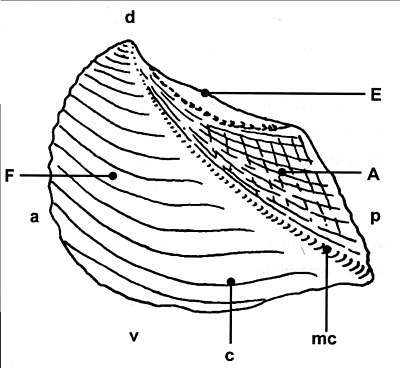Trigonia
Trigonia is an extinct genus of saltwater clams, fossil marine bivalve mollusk in the family Trigoniidae. The fossil range of the genus spans the Paleozoic, Mesozoic and Paleocene of the Cenozoic, from 298 to 56 Ma.[1]
| Trigonia | |
|---|---|
| A fossil shell of T. interlaevigata from Germany, of Jurassic age | |
| Scientific classification | |
| Kingdom: | Animalia |
| Phylum: | Mollusca |
| Class: | Bivalvia |
| Order: | Trigoniida |
| Family: | Trigoniidae |
| Subfamily: | Trigoniinae |
| Genus: | †Trigonia Bruguière, 1789 |
| Species | |
|
See text | |

a) Anterior; p) Posterior; d) Dorsal; v) Ventral; F) Flank; A) Area; c) Costae; mc) Marginal Carina
Trigonia costata ranges from the Lower Jurassic (Toarcian) to Middle Jurassic (Callovian).
Description
The genus Trigonia is the most readily identifiable member of the family Trigoniidae, having a series of strong ribs or costae along the anterior part of the shell exterior. They are the first representatives of the family to appear in the Middle Triassic (Anisian) of Chile and New Zealand. The first European examples (Trigonia costata Parkinson) appear in the Lower Jurassic (Toarcian) of Sherborne, Dorset and Gundershofen, Switzerland.[2]
Species
The following Trigonia species have been described:[1]
- T. analoga
- T. antiqua
- T. castani
- T. castrovillensis
- T. coqueiroensis
- T. costata[2]
- T. cragini
- T. depauperata
- T. eufaulensis gabbi
- T. eufaulensis moorei
- T. guildi
- T. hemisphaerica
- T. imbricata
- T. interlaevigata
- T. intersitans
- T. kitchini
- T. maastrichtiana
- T. maloneana
- T. marginata
- T. mearnsi
- T. montanaensis
- T. orientalis
- T. papuana
- T. picteti
- T. plana
- T. pseudocaudata
- T. pseudocrenulata
- T. pullus
- T. rebouli
- T. reesidei
- T. resoluta
- T. reticulata
- T. saavedra
- T. semiculta
- T. somaliensis
- T. stantoni
- T. stolleyi
- T. suborbicularis
- T. sulcata
- T. taffi
- T. thierachensis
- T. undulatocostata
- T. vyschetzkii
- T. weaveri
Distribution
Fossils of Trigonia have been registered in:[1]
- Permian
Bolivia (Copacabana Formation)
- Triassic
Austria, China, Italy, the Russian Federation, United States (Alaska, Idaho), and Vietnam.
- Jurassic
Afghanistan, Argentina, Canada (Alberta, British Columbia, Yukon), Chile, Colombia (Valle Alto Formation, Caldas),[3] Egypt, Ethiopia, France, Germany, Greenland, India, Iran, Japan, Kenya, Luxembourg, Madagascar, Morocco, New Zealand, Poland, Portugal, the Russian Federation, Saudi Arabia, Somalia, Spain, Tanzania, Thailand, Tunisia, the United Kingdom, United States (Alaska, California, Idaho, Montana, Nevada, Oregon, Texas, Utah, Wyoming), and Yemen.
- Cretaceous
Afghanistan, Algeria, Antarctica, Argentina, Armenia, Australia, Brazil, Bulgaria, Canada (British Columbia), Chile, Colombia (Yuruma Formation, La Guajira, Macanal Formation, Eastern Ranges),[4] Egypt, France, Germany, Greenland, Hungary, Italy, Lebanon, Mexico, the Netherlands, New Zealand, Papua New Guinea, Peru, Portugal, Serbia and Montenegro, South Africa, Spain, Switzerland, Tanzania, Turkmenistan, Russian Federation, Ukraine, the United Kingdom, United States (Arizona, California, Delaware, Mississippi, New Jersey, North Carolina, Tennessee, Texas), Venezuela, and Yemen.
- Paleocene
Argentina (Cerro Dorotea Formation)
References
- Trigonia at Fossilworks.org
- Francis, A.O. (2000). The Palaeobiology of the European Jurassic Trigoniidae. Ph.D. thesis. University of Birmingham. pp. 1–323.
- Mojica, 1984, p.132
- Piraquive et al., 2011, p.204
Bibliography
- Mojica, Jairo. 1984. An outline on the Jurassic in Colombia. Geología Colombiana 13. 129–136. Accessed 2017-03-31.
- Piraquive, Alejandro; Juan Sebastián Díaz; Tomas Cuéllar; Germán Pardo, and Andreas Kammer. 2011. Reactivación Neógena de estructuras de rift del Cretácico Temprano asociadas con la Falla de Chámeza, Pajarito, Boyacá (Colombia): evidencias tectónicas y bioestratigráficas. Geología Colombiana 36. 197–216. Accessed 2017-08-04.